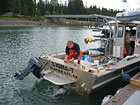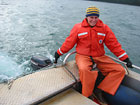

 | |||||||
|
|
Journals 2004/2005Leesa Wingo
July 29, 2004 Today we're planning to test out a new and improved sampling technique for plankton. Lisa and Erica designed a bridle-rope off the stern that will clip into the towline so the net will fish from the center rear of the boat. (Click on thumbnail below for full version pop-up) They were originally going to use quick snap carabineers, but decided to use snap hooks instead. (Use what is available.) The tows were for practice, so we did short 4 minutes ones, but used the dive-watch to check the depth accuracy of the technique. The 10 m. tows went well. The net opened and closed without a hitch. The boat was easy to pilot, no longer becoming 'possessed' by the currents from below, tossed around, or prevented from turning or fishing correctly. The 30 m. tows were slightly more challenging. Initially, the net sank far deeper, then surged up to a more shallow depth. The range was around 30 m., but never exactly 30 m. Erica and Lisa wanted to practice as a two-some, so my help was superfluous since I was leaving tomorrow. My job was net-washer and chief plankton processor. Their technique was smooth after just a couple of runs. Since it was practice, I was lucky enough to keep the plankton for my classroom. The students will be able to sort and identify the different types of zooplankton this fall in Marine Biology class. (Click on thumbnail below for full version pop-up) We were going to work until 1:30, but were having so much fun that we stayed out until 4:30. On the way in, there was a loud SQUEAL AND A BLAM. The engine stopped, and so did the boat. After a look under the engine cover, Lisa discovered one of the belts disintegrated, and another one flipped over. Yeow! See if you can tell where the belt is off its pulley. (Click on thumbnail below for full version pop-up) Erica started the kicker motor, and we raced into port at 5 knots. It took about an hour to go a distance that would normally take us 20 minutes. (Click on thumbnail below for full version pop-up) It figures. When the scientific technique solidifies for the team, the belts go haywire. Scientists have to deal with so many more variables than just simply the "independent and dependent variables" from the textbooks we learn about in school. It is incredible so much even gets done with so many components to be organized and throw weather conditions and mechanical problems on top of that! In the evening, Lisa had all of the research biologists and assistants to her house for a dinner of fresh halibut. We all told stories of our most embarrassing field camp and research moments. These had everyone rolling and howling with laughter. Due to scientific intellectual property, these tales cannot be printed here. The hysterical end of an excellent field adventure. Return to Journals Index |
||||||



